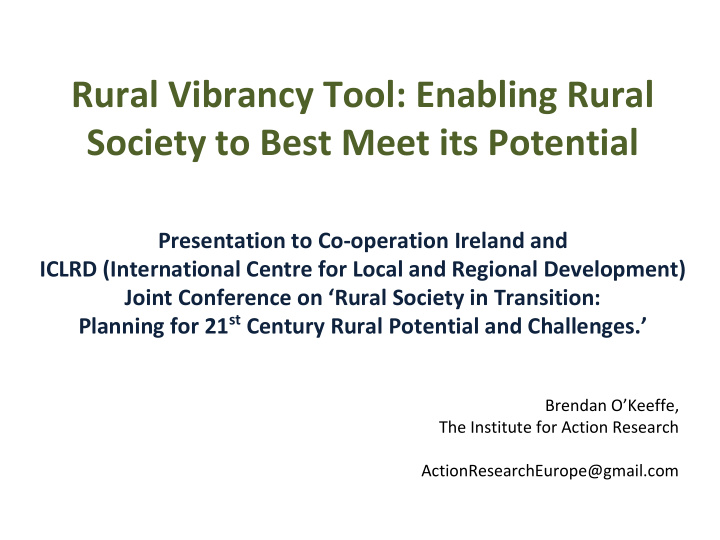



Rural Vibrancy Tool: Enabling Rural Society to Best Meet its Potential Presentation to Co-operation Ireland and ICLRD (International Centre for Local and Regional Development) Joint Conference on ‘Rural Society in Transition: Planning for 21 st Century Rural Potential and Challenges.’ Brendan O’Keeffe, The Institute for Action Research ActionResearchEurope@gmail.com
Contents 1. The Concept and Definition of Rural Vibrancy 2. Methodology 3. Presentation of Results a. Civil Society and Community Vibrancy b. Citizens’ Perceptions of Rural Vibrancy 4. Observations and Recommendations 5. The Tool in Use today
1. Defining Rural Vibrancy “A new OECD report, Promoting Growth in All Regions , provides fresh analysis that shows how relatively backward regions can in fact be potentially important sources of growth, but that a very different approach is needed to tap that potential” • Urbanisation is associated with higher levels of output but not necessarily faster growth; • Fast-growing less developed regions tend to have higher levels of human capital; • Faster-growing intermediate regions are characterised by better infrastructure, connectivity and innovation; • Addressing the problems of low-skilled workers may matter more than increasing tertiary attainment rates in less developed regions
Declining Vibrancy “The role of the village ‘local’ as a vibrant social centre at the heart of the community is as important as ever, but the future of the pub in our rural communities is increasingly under threat” (Sternad, Kennelly and Bradley, 2016: 109).
Community Vibrancy Domain Social Engagement Attitudes towards Others • Social Participation and Community • Civic Participation • Trust • Economic Participation • Respect for Diversity • Altruism Social Support • Sense of Belonging • Size of Social Networks • Reciprocity Community Safety • Crime (non) • Perception of Safety Canadian Council on Social Development, 2010
2. Methodology • Data collected as part of an INTERREG Project (NW Europe) on Rural Alliances and Measuring Rural Vibrancy. • Inspired by Collaboration with CIEL (Centre for Innovative and Entrepreneurial Leadership) • Survey Work in South Kerry 1. Survey of 104 Civil Society Organisations 2. Mapping of Public Service Provision 3. Survey of c.1000 citizens on community vibrancy • Follow-Up / Ongoing work with Communities
Rural Alliances’ Partners 1. Brecon Beacons National Park Authority [UK] 2. University of Wales, Trinity St David [UK] 3. Innovatiesteunpunt vzw [BE] 4. Vlaamse Landmaatschappij (VLM) [BE] 5. Stichting Streekhuis Het Groene Woud & De Meierij [NL] 6. Huis van De Brabantse Kempen (NL) 7. Gemeente Lochem [NL] 8. Philipps-Universität Marburg, Fachbereich Geographie (DE) 9. South Kerry Development Partnership Ltd. [IE] 10. Comhairle Contae Mhaigh Eo (Mayo County Council) (IE) 11. Maison de l’Emploi, de Développement, de la Formation et de l’Insertion du Pays de Redon – Bretagne Sud (MEDEFI) [FR] 12. Laval Mayenne Technopole (FR)
3. Presentation of Results a. Civil Society and Community Vitality b. Service Provision c. Citizens’ Perceptions of Rural Vitality
Community Groups i.e. Civil Society provides vital local services and promotes development Participative Democracy <-> Community Development
Who engages? Membership of Voluntary Organisations
How Groups Operate – Percentage of Groups with the following features.
Perceptions on the Impact of SKDP
Issues Pursued by Communities through Planning and Policy
Main Issues facing our Community
Citizens’ Perceptions of Place Recap 972 citizens surveyed Representative Sample, stratified by Geography. Multiple Indictors of Economic, Socio-Cultural and Environmental Vitality and Well-Being
Levels of Agreement or Disagreement with Statements about Economic Vitality among Citizens in South Kerry
Citizens’ Perceptions of Economic Vitality– on selected indicators, by Community Forum Area P<.001, Cramer’s V=.132 P<.001, Cramer’s V=.155
Economic Vibrancy - Cumulative Score for each community
Percentage of Persons in Agreement with Statements about Socio-Cultural Vibrancy in their Communities. % of Persons in Indicators of Socio-Cultural Vibrancy Agreement People greet each other, regardless of whether or not they know them. 84.0 We have at least one public festival annually. 82.2 Citizens are committed to this community—they have a strong sense that they belong here. 80.1 We have good sports and recreation facilities in this community. 79.2 There are good facilities for meetings locally. 78.2 The community has a distinct culture and heritage that are appreciated by the community. 78.1 Citizens are interested in national and international news and current affairs. 77.0 You see many active, healthy-looking seniors in this locality. 75.2
Levels of Agreement or Disagreement with Statements about Environmental Vibrancy among Citizens in South Kerry
Cumulative Scores for Communities across the Four Community Forum Areas on the Dimensions of Sustainable Development
4. Observations and Recommendations • Higher levels of socio-cultural vibrancy than economic vibrancy. • Highest levels of economic vibrancy correlate with population • Highest levels of socio-cultural vibrancy correlate with: – Rurality – Leadership (little red hen philosophy) – LEADER
Recommendations • All places have potential. • Recognise Civil Society as ‘The Fifth Estate’ • Broaden participation – especially by youth. • Resource and mainstream social economy / community business. • Enforce minimum targets for public service provision • Promote the Co-Creation of Vitality / Vibrancy.
5. Measuring Vibrancy -> -> Participatory Community Planning
Recommend
More recommend